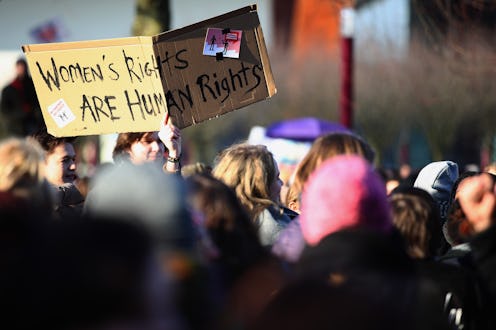
On March 8, the world gathers together to celebrate International Women's Day. This year, the observance's theme is #BeBoldForChange, a call to arms that acknowledges the current political climate and urges all humans to stand up and fight, fiercely, for the protection of the rights of all. But why does International Women's Day have a theme in the first place? Though the branding is relatively new, this time-honored day of activism has deep roots.
Women's Day began in 1909, though the event that spurred its establishment, a 15,000-strong women's march through New York City demanding shorter hours, better pay and voting rights, occurred in 1908. The next year, in accordance with a decree from Socialist Party of America (yes, really), National Women's Day was celebrated across the United States. It remained on the final day of February until 1913.
The first International Women's Day (IWD) happened in 1911, and was honored in Austria, Denmark, Germany and Switzerland on March 19. Across these countries, over 1 million (YES, REALLY) people of all genders attended rallies calling for women's right to work, vote, hold public office, and to end discrimination. In 19freaking11.
Less than a week later, the infamous Triangle Shirtwaist Fire occurred in New York City, resulting in the deaths of over 140 workers, most of whom were Italian and Jewish immigrants. Especially due to its close proximity to the first International Women's Day, this event is often pointed to as strengthening the mission of the observance; IWD fought for the very things that could have prevented such a tragedy from occurring.
In 1996, the United Nations, who had taken over the helm of IWD in 1977, introduced the tradition of picking an annual theme; the first, "Celebrating the past, Planning for the Future," was followed by "Women at the Peace Table." More recent themes include "A Promise is a Promise - Time for Action to End Violence Against Women" (2013), and "Empower Rural Women, End Poverty & Hunger" (2007).
By 2000, though, the active participation in IWD had seriously waned; the issues protested in the early 1900s were still issues. In many ways, women were in remarkably similar positions to their radical predecessors. The next year, an official IWD website was established, in a sort of 21st century call to action. Each year, the website adopts a theme as an way to focus the goals of the observance; it's supported by a number of international sponsors. Fundraising efforts go towards supporting their long-time favorite charity, World Association of Girl Guides and Girl Scouts.
So the next time you hear #BeBoldForChange, which you are certain to over the next week, remember the movement's radical beginnings. Remember the fire and the momentum. Remember that it's always worth fighting.
Check out the “Feminism” stream in the Bustle App throughout the month of March for more inspiring ways to celebrate Women's History Month.